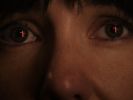Eye For Film >> Movies >> Fréwaka (2024) Film Review
Fréwaka
Reviewed by: James Gracey

Fréwaka (from the Irish ‘Fréamhacha’, meaning ‘roots’) is a chilling Irish-language folk horror that not only draws inspiration from Ireland’s rich well of creepy folklore, traditions and mythology, but serves as a startling rumination on the cruel, ill-treatment of women throughout its history. It tells of Shoo (Clare Monnelly), a troubled care worker sent to a remote village to care for Peig (Bríd Ní Neachtain), an older agoraphobic woman who claims the Na Sídhe – sinister, malevolent faerie folk - abducted her on her wedding night decades before.
Written and directed by Aislinn Clarke, Fréwaka is a kindred spirit of several notable Irish horror titles, including The Daisy Chain (2008), The Hole In The Ground (2019) and You Are Not My Mother (2021), which all utilise the presence of otherworldly folkloric entities, particularly the faerie changeling, to offer commentary on Ireland’s troubled social history, women’s autonomy, and intergenerational trauma. Like her debut feature The Devil’s Doorway (2018), a found-footage creeper set in a Magdalene Laundry, Fréwaka also has a lot to say about the shocking historic treatment of women in Ireland. The spectre of the Church materialises throughout, a reminder of the guilt, abuse (and cover-ups) and stifling hold it held over people, especially unmarried pregnant women.

Clarke’s screenplay deftly illustrates tensions between the past and the present, and how the two, especially in Ireland, are oftentimes separated by the wispiest of veils. Peig clings to rural superstitions and practices to keep dark forces from entering her home. Shoo is a refreshingly modern character representative of Ireland’s shift in societal attitudes towards women’s autonomy, LGBT+ equality, mental health issues, and multiculturalism. As the two women begin to trust each other, kindle a friendship and share their own stories of abusive upbringings, familial trauma and forced marriages, Shoo is drawn into Peig’s superstitions and paranoia. This is when the real horror of the story begins to emerge, and it runs in parallel with the manifestation of a disturbing presence in the house and odd occurrences that can’t be explained away.
Clarke’s direction is measured and quiet, as she slowly unshrouds the story and beckons the audience ever deeper into its depths. From the outset, she introduces the idea of the otherworldly encroaching upon mundane reality but conjures an air of ambiguity to keep it grounded (whispers of dementia, mental ill-health). Her characters are fully fleshed and exhibit rich inner lives. Shoo and Peig are flawed and vulnerable, but they are also resilient, sharp and wise. Clare Monnelly and Bríd Ní Neachtain contribute powerful, moving performances which ground the supernatural aspects of the story in a very relatable, believable reality, fuelling the film’s stark power.
The score courtesy of Die Hexen (composer and filmmaker Dianne Lucille Campbell) evokes and sustains a moody sense of dread throughout, several times shifting to ferocious intensity. The use of silence in certain moments is also highly effective. Indeed, one of the most terrifying moments occurs in broad daylight on a lonely country lane as Shoo danders home from town with the unshakable feeling something is following closely behind her…
The film is laced with folk horror imagery that centres its themes of dark lineages and the grip of the past and the old ways upon the present: fairy trees – still revered in certain parts of the country - adorned with ribbons and other offerings of household trinkets and paraphernalia; covered mirrors and reflective surfaces; certain objects of power placed in specific spots to ward off harmful forces. The nightmarish countenance of the ‘straw boys’, as they make their way to Peig’s wedding, and the terrifying figure in a burial gown that stalks Shoo in the cellar, are unnervingly striking.
Clarke’s utilisation of eerie Irish lore and the supernatural to explore very real horror, and the lifelong lingering aftermath of a single, damning moment, is a potent and unsettling brew. While they are in the stranglehold of cruel and manipulative faerie folk, the lived experiences of Peig and Shoo, which have rendered them ghosts in their own lives, is also marked by the Church’s cloaking in shame of vulnerable, marginalised women. The blood curse that courses through their lineage is a striking allegory for intergenerational trauma and the lived horror of growing up in the grasp of the past, utterly powerless to properly grieve and untangle from it. A dark, haunting story told with effective restraint and punctuated with moments of impish humour and genuine terror.
Reviewed on: 09 Aug 2024














